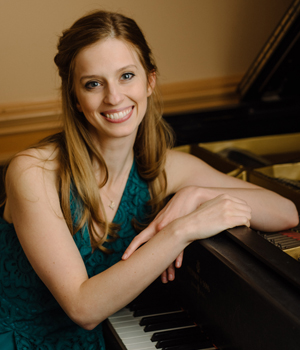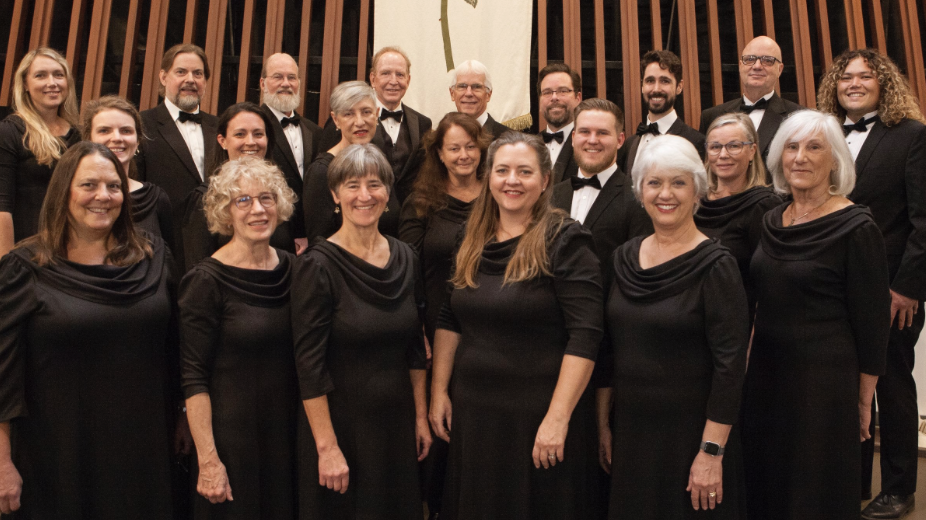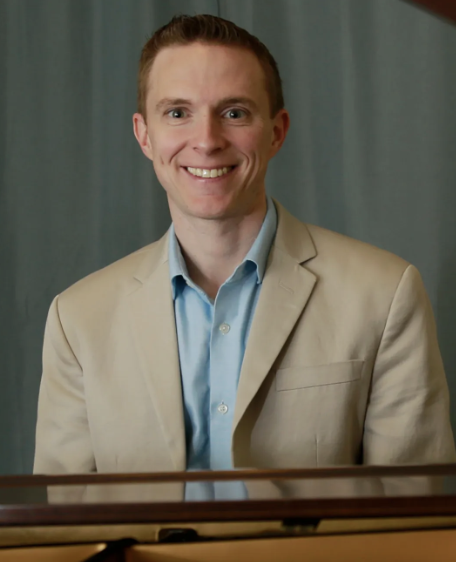| Recent Reviews |
 |
CHORAL AND VOCAL
CANTIAMO SONOMA'S LUSCIOUS A CAPELLA SINGING IN SEASON ENDING CONCERT
by Pamela Hicks Gailey
Sunday, June 8, 2025
Cantiamo Sonoma concluded their 2024-25 season June 8 at St. Seraphim of Sarov Orthodox Cathedral, going out perhaps not with a bang, but certainly with a sigh of happy accomplishment. Although not packed, the appreciative audience was fairly full and enthusiastic.
Director Carol Menke led five se...
SYMPHONY
SRS SEASON ENDS WITH RESOUNDING TA-TA-TA-BANG
by Terry McNeill
Sunday, June 1, 2025
Finishing the 97th season, the Santa Rosa Symphony took a long stride June 1 on its “Road to 100” odyssey in a dramatic concert before an audience of 1,200 in Weill Hall. The “Road to 100” is a celebratory march and marketing slogan set to spotlight the Symphony’s nearly 100 years of concerts, and a...
SYMPHONY
YOUTHFUL VIRTUOSITY ON DISPLAY AT USO'S MAY CONCERTS
by Peter Lert
Saturday, May 17, 2025
 USO May 18 in Center Theater |
The final concert of the Ukiah Symphony's 2024-2025 season featured the winners of the Orchestra's Youth Concerto Competition, for which entrants must be undergraduate student musicians. Winners were flutist Sungdu Bae, a senior at Sonoma State University, and violinist Serena She, a freshman conser...
SYMPHONY
MYSTICAL PLANETS AND LIVELY GERSHWIN ORTIZ AT FINAL SRS CONCERT
by Peter Lert
Sunday, May 4, 2025
For their final concert of the 2024-2025 season the Santa Rosa Symphony programmed, in addition to a contemporary piece by Mexican composer Gabriela Ortiz, two proven crowd pleasers: Gershwin’s 1925 Concerto in F, and Holst’s orchestral suite The Planets, composed during the first World War. These p...
SYMPHONY
VSO'S CONCERT MUSIC OF TIME, MUSIC OF PLACE
by Peter Lert
Sunday, April 27, 2025
 Pianist Elizabeth Dorman |
The Vallejo Symphony's final concert of the 2024-2025 season was performed April 27 in their usual venue, Vallejo's historic Empress Theater. Built in 1911 as one of the first small “movie palaces” in northern California, it went through various incarnations before being lovingly restored, complete ...
VOCAL ELEGANCE AND FIRE AT THE 222'S RECITAL APRIL 26
by Pamela Hicks Gailey
Saturday, April 26, 2025
The opera series at Healdsburg’s 222 Gallery closed its season April 26 in a splendid program given by virtuoso soprano Chelsea Hollow with pianist Taylor Chan.
It was a smallish audience for this eclectic program of art songs and cabaret pieces, yet Ms. Hollow sang the vocal pyro techniques as if ...
CANTIAMO SONOMA SINGS AN INSPIRED GOOD FRIDAY MOZART REQUIEM CONCERT
by Pamela Hicks Gailey
Friday, April 18, 2025
 Cantiamo Sonoma |
In retrospect, Cantiamo Sonoma’s April 18 performance of Mozart’s Requiem sadly presaged the loss of Pope Francis on Easter Monday. Santa Rosa’s Church of the Roses was packed even more than usual for their annual Good Friday concert, and Carol Menke led a musically solid, powerfully heartfelt rendi...
DRAMATIC SHOSTAKOVICH SYMPHONY CLOSES PHILHARMONIC'S 25TH SEASON
by Terry McNeill
Sunday, April 13, 2025
Sonoma County Philharmonic’s season ending concerts always program a work that can be a stretch for the all-volunteer orchestra, and April 12 and 13 found Shostakovich’s demanding D Minor 5th Symphony the piece de resistance.
The weekend pair of concerts, conducted by Norman Gamboa in his th...
LARGE COLLEGE OF MARIN AUDIENCE GREETS STOPHER ARTISTRY
by Terry McNeill
Saturday, April 5, 2025
 Pianist Jim Stopher |
Music department faculty recitals are a rare commodity on the North Coast, and over many years one looked in vain for artist performances at Santa Rosa JC, Dominican University, Mendocino College, Sonoma State University, Napa College and Pacific Union College.
No so at College of Marin, where facu...
CHAMBER
FRISSON DELIVERS SHIVERS OF DELIGHT
by Abby Wasserman
Sunday, March 30, 2025
“Frisson” means “a moment of intense excitement…a shiver,” and that’s what Frisson Nonet provided nonstop on March 30 at Mt. Tamalpais Methodist Church in Mill Valley. Their dynamic performances of works by Rossini, August Walter, Gershwin, Martinú and Ravel marked Chamber Music Marin’s season close...
|
 |
 |
|
 |
MC2 DUO RECITAL CLOSES 222'S SEASON
by Terry McNeill
Saturday, June 14, 2025
The Noth Coast’s premier multi art concert venue, Healdsburg’s 222 Gallery, closed their season June 14 with a recital by violinist Gary McLaughlin and pianist Rose McCoy. Mr. McLaughlin is the 222’s classical music producer and has long been associated with Healdsburg area music.
It was an odd menu of works, with just one lengthy composition, but an audience of 55 seated at cabaret tables enjoyed the informality of the presentation and the violinist’s remarks from the stage, albeit often extended excursions into ephemera.
Brahms G Major Sonata was the evening’s pièce de résistance, played with score as all the program’s works were, and at judicious tempos that continued through the program. Over 29 minutes the duo adopted a low energy approach with little thematic projection and avoiding the big buildup to the last few bars of the opening Vivace.
Balances in this wonderful work were good and the thematic relationships in the first and last movements were emphasized. Sound was direct with minimal reverberation and occasional wandering intonation. Mr. McLaughlin stretched the final phrases in the Allegro molto to affect a suave and lovely ending.
The concert surprisingly began with two short Telemann Fantasies for solo violin, Nos. 9 (B minor) and 12 (A Minor), composed in 1735, and each in three sections and sounding like demanding practice room studies. The Vivace part of the B Minor was the most Bach like, and the following Allegro the most extended and was played with light vibrato. The violinist used a baroque-era bow for these pieces and mastered the big skips in the harmonically interesting high-register Vivace from the A Minor, the descending phrases in the concluding Presto were gracious.
Ms. McCoy played two solo works, Chopin’s Polonaise from Op. 40, No. 2, and Debussy’s La Cathédral Engloutie from his first book of Preludes (1910). Playing in the C Minor Polonaise had good drama and fetching held notes with short accelerandos and full right hand chords. The five-minute Debussy had an oriental harmonic character, precise pedaling and rich resonance. With the Telemann it was a concert highlight.
A short encore, Brahms’ Scherzo contribution to the 1853 F.A.E Sonata, was played with indifferent audience reaction and dry tone.
|
 |
CHAMBER
Valley of the Moon Music Festival
Saturday, July 12, 2025
4:00 PM - Sonoma
Tanya Tomkins and Eric Zivian, Directors; performers TBA
Music of Fanny and Felix Mendelssohn, Bach
Tickets are $45; patio reception to follow
...
Details
CHAMBER
Valley of the Moon Music Festival
Saturday, July 12, 2025
2:30 PM - Sonoma
Tanya Tomkins and Eric Zivian, Directors
Blattner Series Lecture. Speaker TBA
Free to VOM Festival ticket holders...
Details
CHAMBER
Valley of the Moon Music Festival
Sunday, July 13, 2025
4:00 PM - Sonoma
Tanya Tomkins and Eric Zivian, Directors. Performers TBA
Wagner and the French. Music of Chausson, Debussy and Wagner. Program TBA
Tickets are $45...
Details
CHAMBER
Piano Sonoma
Thursday, July 17, 2025
5:30 PM - Rohnert Park
Gabrielle Chu, Christine Wu and Sara Kasman Laude, piano; Doori Na, violin; Kara Dugan, mezzo-sopran
Vino & Vibrato. Bach: Organ Sonata in C Major (Largo), BWV 529 (for piano); Chopin: B major Nocturne, Op. 62, No. 1; Juhi Bansal: Life, Loss and Exile (selections); Gabriel Kahane: Works on Paper; Rav...
Details
RECITAL
Mendocino Music Festival
Saturday, July 19, 2025
2:30 PM - Mendocino
Rachel Breen, piano
Etudes TBA; Bull: Fantasia on Ut Re Mi Fa Sol La; Stravinsky Trois Mouvements de Petruahka
Tickers $15 to 40...
Details
CHAMBER
Valley of the Moon Music Festival
Saturday, July 19, 2025
4:00 PM - Sonoma
Tanya Tomkins and Eric Zivian, Directors. Performers TBA
Nadia Boulanger. Music of Fauré, Stravinsky and Piazzolla
Tickets bare $45...
Details
CHAMBER
Valley of the Moon Music Festival
Tuesday, July 22, 2025
7:00 PM - Sonoma
Tanya Tomkins and Eric Zivian, Directors. Performers TBA
Alfresco Concert II. Mendelssohn: Octet; music for violin and guitar. Program TBA
Admission: $45...
Details
CHAMBER
Piano Sonoma
Tuesday, July 22, 2025
5:30 PM - Rohnert Park
Doori Na and Gabrielle Chou, violin; Mike Dahlberg, cello; Christine Wu, Sasha Kasman Laude and Pete
Vino & Vibrato. Rachmaninoff: Trio Elégiaque in G Minor; John Adams: Road Movies; Piazzolla: selections from the "Four Seasons"; Ellington: Azalea, Black and Tan Fantasy, In a Sentimental Mood
Concer...
Details
CHAMBER
Piano Sonoma`
Thursday, July 24, 2025
5:30 PM - Rohnert Park
Peter Dugan, Gabrielle Chou, Sara Kasman Laude, Michael and Jessica Chow Shinn, piano; Mike Dahlberg
Vino & Vibrato. Piazzolla: selections from the "Four Seasons"; Leonardo Dugan: Easy Have, Cozy Life; Riley Mulherkar: Untitled, Hopscotch; Peter Dugan: TBD (world premiere); Shchedrin: Basso Ostinato;...
Details
CHAMBER
Valley of the Moon Music Festival
Saturday, July 26, 2025
4:00 PM - Sonoma
Tanya Tomkins and Eric Zivian, Directors. Performers TBA
Americans in Paris. Music of Milhaud, Ravel, Gershwin, Debussy. Program TBA
Admission is $45...
Details
|




